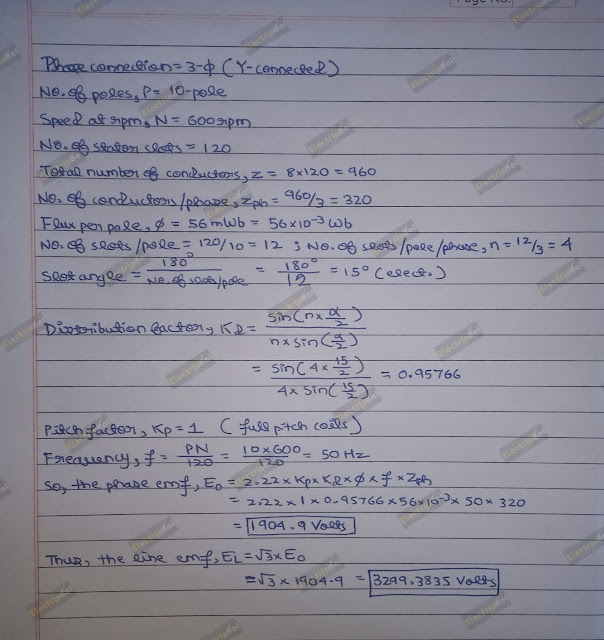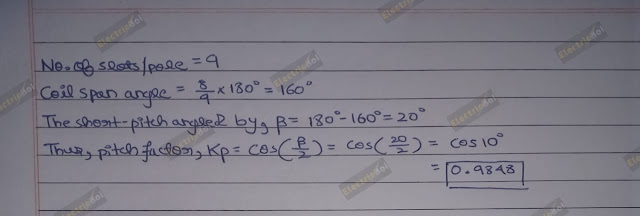Harmonics are unwanted higher frequencies which superimposed on the fundamental waveform creating a distorted wave pattern. The sources of harmonics in the output voltage waveform are the non- sinusoidal waveform of the field flux.
When the uniformly sinusoidal distributed air gap flux is cut by either the stationary or rotating armature sinusoidal EMF is induced in the alternator. Hence the nature of the waveform of induced EMF and current is sinusoidal. But when the alternator is loaded waveform will not continue to be sinusoidal or becomes non sinusoidal. Such non sinusoidal wave form is called complex wave form.
By using Fourier series representation, it is possible to represent complex non sinusoidal waveform in terms of series of sinusoidal components called harmonics, whose frequencies are integral multiples of fundamental wave.
The fundamental wave form is one which is having the frequency same as that of complex wave. The waveform, which is of the frequency twice that of the fundamental is called second harmonic. The one which is having the frequency three times that of the fundamental is called third harmonic and so on. These harmonic components can be represented as follows.
Fundamental: e1 = Em1 Sin (ωt ± θ1)
2nd Harmonic e2 = Em2 Sin (2ωt ± θ2)
3rd Harmonic e3 = Em3 Sin (3ωt ± θ3)
5th Harmonic e5 = Em5 Sin (5ωt ± θ5) etc.
In case of alternators as the field system and the stator coils are symmetrical the induced EMF will also be symmetrical and hence the generated EMF in an alternator will not contain any even harmonics.
Q1. An alternator has 18 slots/pole and the first coil lies in slot 1 and 16. Calculate the pitch factor for (i) fundamental
(ii) 3rd Harmonic
(iii) 5th Harmonic
(iv) 7th Harmonic
ARMATURE REACTION IN ALTERNATOR
When an alternator is running at no-load, there will be no current flowing through the armature winding and the flux produced in the air-gap will be only due to the rotor ampere- turns.
When load current flows through the armature windings of an alternator, the resulting mmf produces flux. This armature flux reacts with the main-pole flux, causing the resultant flux to become either less than or more than the original main flux.
The effect of the armature (stator) flux on the flux produced by the rotor field poles is called armature reaction
.
Two things are worth noting about the armature reaction in an alternator.
• First, the armature flux and the flux produced by rotor ampere-turns rotate at the same speed (synchronous speed) in the same direction and, therefore, the two fluxes are fixed in space relative to each other.
• Secondly, the modification of flux in the air-gap due to armature flux depends on the magnitude of stator current and on the power factor of the load. It is the load power factor which determines whether the armature flux distorts, opposes or helps the flux produced by rotor ampere-turns.
To illustrate this important point, we shall consider the following three cases:
1. When load P.f. is unity
2. When load P.f. is zero lagging.
3. When load P.f. is zero leading.
When load Power factor is unity
Since the armature is on open-circuit, there is no stator current and the flux due to rotor current is distributed symmetrically in the air-gap. Since the direction of the rotor is assumed clockwise, the generated e.m.f. in phase R₁R₂ is at its maximum and is towards the paper in the conductor R₁ and outwards in conductor R₂. No armature flux is produced since no current flows in the armature winding.
According to right hand rule, the current is “in” in the conductors under N-pole and “out” in the conductors under S-pole. Therefore, the armature flux is clockwise due to currents in the top conductors and anti clockwise due to currents in the bottom conductors. The armature flux is at 90° to the main flux (due to rotor current) and is behind the main flux. In this case, the flux in the air-gap is distorted but not weakened. Therefore, at unity p.f., the effect of armature reaction is merely to distort the main field; there is no weakening of the main field and the average flux practically remains the same. Since the magnetic flux due to stator currents (i.e., armature flux) rotate; synchronously with the rotor, the flux distortion remains the same for all positions of the rotor.
When load Power factor is Zero lagging
When a pure inductive load (zero P.f. lagging) is connected across the terminals of the alternator, current lags behind the voltage by 90°. This means that current will be maximum at zero e.m.f. and vice-versa.
When the alternator is supplying a pure inductive load, the current in phase R₁R₂ will not reach its maximum value until N-pole advanced90° electrical
Now the armature flux is from right to left and field flux is from left to right.All the flux produced by armature current (i.e., armature flux) opposes the field flux and, therefore, weakens it. In other words, armature reaction is directly demagnetizing. Hence at zero P.f. lagging, the armature reaction weakens the main flux. This causes a reduction in the generated e.m.f.
When load Power factor is Zero leading
When a pure capacitive load (zero P.f. leading) is connected across the terminals of the alternator, the current in armature windings will lead the induced e.m.f. by 90°. The effect of armature reaction will be the reverse that for pure inductive load. Thus armature flux now aids the main flux and the generated e.m.f. is increased. When alternator supplying resistive load ,e.m.f. as well as current in phase R₁R₂ is maximum in the position.
When the alternator is supplying a pure capacitive load, the maximum current in R₁R₂ will occur 90° electrical before the occurrence of maximum induced e.m.f. Therefore, maximum current in phase R₁R₂ will occur if the position of the rotor remains 90° behind as compared to its position under resistive load.
It is clear that armature flux is now in the same direction as the field flux and, therefore, strengthens it. This causes an increase in the generated voltage. Hence at zero P.f. leading, the armature reaction strengthens the main flux.

ALTERNATOR ON LOAD
When the load on the alternator is increased (i.e., armature current Ia is increased), the field excitation and speed being kept constant, the terminal voltage V (phase value) of the alternator decreases. This is due to
i. Voltage drop 𝐼𝑎𝑅𝑎 where 𝑅𝑎 is the armature resistance per phase.
ii. Voltage drop 𝐼𝑎𝑋𝐿 where 𝑋𝐿 is the armature leakage reactance per phase.
iii. Voltage drop because of armature reaction.
i. Armature Resistance (Rₐ)
Since the armature or stator winding has some resistance, there will be an IₐRₐ drop when current (Iₐ) flows through it. The armature resistance per phase is generally small so that 𝐼ₐ𝑅ₐ drop is negligible for all practical purposes.
ii. Armature Leakage Reactance (XL)
When current flows through the armature winding, flux is set up and a part of it does not cross the air-gap and links the coil sides. This leakage flux alternates with current and gives the winding self-inductance. This is called armature leakage reactance. Therefore, there will be 𝐼𝑎𝑋𝐿 drop which is also effective in reducing the terminal voltage.
iii. Armature reaction
The load is generally inductive and the effect of armature reaction is to reduce the generated voltage. The armature reaction effect is accounted for by assuming the presence of a fictitious reactance Xₐᵣ in the armature winding. The quantity Xₐᵣ is called reactance of armature reaction. The value of IₐXₐᵣ represents the voltage drop due to armature reaction.
 |
| Unity power factor load |
 |
| Lagging power factor load |
 |
| leading power factor load |
Q1:- A 500 kVA, 3-Phase, star connected alternator has a rated line-to-line voltage of 3300V. The resistance and synchronous reactance per phase are 0.3 ohm and 4 ohm respectively. calculate the line value of the e.m.f generated at full-load, 0.8 p.f. lagging.
Q2:- A 1000 kVA, 2300V, 3-phase, star-connected alternator has a resistance of 0.309 ohm/phase and a synchronous reactance of 3.31 ohm/phase. Calculate the change of line voltage when the rated output of 1000 kVA at power factor of 0.8 lagging is switched off. Assume the speed and the exciting current to remain unaltered.
























































4 Comments
Nice work ��
ReplyDeleteThank you :)
DeleteReally helpful Blog
ReplyDeleteI hope so :))
Delete